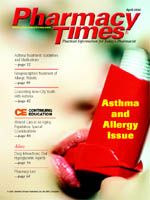Publication
Article
Pharmacy Times
Preparing for a JCAHO Survey
The 19,000 health care facilities accredited by the Joint Commission on Accreditation of Healthcare Organizations (JCAHO) have successfully completed a rigorous, voluntary process.1 Understandably, many pharmacists approach accreditation with apprehension. Following some tips can ensure both Pharmacy's compliance and a successful outcome.
To start with, pharmacists should understand the intent of the JCAHO. Standards fall primarily into 2 categories: improving quality and decreasing adverse outcomes. Furthermore, all JCAHO standards and their related chapters address 1 of 3 major functions (Table 12). Now, follow these 10 tips.
1. Know Applicable Standards and Regulations
Navigate the manual's index, which cross-references all standards. Under "Pharmacy," even those standards in chapters ostensibly unrelated to Pharmacy (eg, Nutritional Assessment, Management of Human Resources) are itemized. JCAHO surveyors also monitor compliance with applicable state laws and regulations, so review state requirements.
Visit the JCAHO's Web site (www.jcaho.org), frequently. It provides additional information about standards, as well as JCAHO's National Patient Safety Goals. Initiated in 2003, these goals specify patient-safety priorities, and some change annually. Of the goals for 2004, 3 are clearly pharmacy priorities:
- Improve communication effectiveness among caregivers. (Implement a process for taking verbal or telephone orders. Standardize abbreviations, acronyms, and symbols used throughout the organization.)
- Improve high-alert-medications safety. (Remove concentrated electrolytes from patient-care units. Standardize and limit the number of drug concentrations available in the organization.)
- Improve infusion-pump safety. (Ensure free-flow protection on all general-use and patient-controlled analgesia- infusion pumps.)3
2. Start NOW
Do not wait until a survey is scheduled, or surveyors are at the door. Ensuring compliance is time-consuming and requires extensive multidisciplinary collaboration.
3. Put Quality First
The JCAHO expects the pursuit of quality to drive your decisions. Establish a circular, continuous quality-improvement process. That is, ensure that all quality gaps are addressed with SMART (Specific, Measurable, Achievable, Realistic, and Time-limited) goals and indicators. Correct more than just surface issues (eg, removing expired drugs from emergency carts). Identify process flaws that allow gaps (eg, no monthly inspections), and monitor them until they are fixed. Then, select new goals, while watching that previously corrected items do not backslide. Staff and committee meetings are excellent venues for addressing progress (or lack thereof) toward goals; make your goals standing agenda items.
4. Review Policies and Procedures Routinely
The JCAHO requires policies and procedures (reviewed at least every 3 years) that conform to accreditation standards. Many department heads have been embarrassed after praising a Pharmacy policy, only to learn from a surveyor that half of the staff was unaware of the policy's existence. Be prepared to tell surveyors how policy changes are communicated to the staff.
5. Conduct Self-Assessment and Mock Surveys
To assess your current status, extract all Pharmacy-related standards and make a chart like this:
Make copies and ask staff members to rate compliance. (This step serves 2 purposes: all staff members learn the standards/ policies and participate in solutions.) Discuss results openly. Perceptions of compliance vary among "surveyors" (staff), so conduct mock surveys: Ask staff members to survey other Pharmacy areas, test staff members' familiarity with key policies, and assess what they see honestly.
6. Understand Pharmacy's "Place"
The JCAHO focuses on inter-, cross-, and multidisciplinary processes and functions. Whereas most pharmacists are vigilant about their clinical committees and functions (eg, Pharmacy and Therapeutics Committee), they may eschew administrative or interdependent functions. How do you determine budget and staffing adequacy? How does Pharmacy work cohesively with Dietary? Does the Human Resources staff know and incorporate core competencies into position announcements? Do Pharmacy and Nursing share medication-error data and collaborate on corrective action?
7. Document Responsively
JCAHO surveyors value succinct meeting minutes that clearly track issues, recommendations, actions, and followup. Many recommendations are lost to follow-up in subsequent minutes. One successful method for ensuring responsive minutes is as follows: State the Issue, Discussion, and Action/Outcome or Deliverable for each agenda item. Use the Action/Outcome or Deliverable line when creating the next meeting's agenda. Periodically, audit meeting minutes for continuity and responsiveness to issues.
8. Organize Local Personnel Files
Keep local (departmental) personnel files with 4 JCAHOrequired categories of documents:
- Copies of licenses, clinical privileges, and credentials
- Evidence of mandatory training (eg, annual infection control, cardiopulmonary resuscitation)
- Performance evaluations, current performance plans, employee training needs
- Personal information, including documentation of required annual health screening
Often, employees are compliant, but managers fail to update local records. (Surveyors are not favorably impressed when managers call staff members during the survey to fax needed documents.) Assign 1 person, perhaps a trustworthy clerk or technician, to track employee activities and periodically update personnel folders.
9. Maintain Accreditation Notebooks or Folders
Maintaining readily retrievable policies, meeting minutes, quality-improvement plans, and compliance documentation prevents "things from falling through the cracks." Producing records (Table 2) quickly when surveyors appear unannounced demonstrates commitment to improving care and safeguarding patients.4
10. Survey Day Is Here!
Adjust your expectations, and stay calm. Survey days are often plagued with unpredictable events, so clear your calendar and remain flexible. (Keep nutritious snacks on hand; they may be your lunch.) If surveyors note a deficiency, take immediate corrective action. Share your action with the surveyor, and ask for feedback. This approach may avoid a deficiency, but, more important, it demonstrates commitment to improving care.4
Conclusion
The best preparation for a survey is constant readiness, particularly because some surveys are unscheduled. The objective is not merely to pass the survey, but to provide quality patient care.
For a list of references, send a stamped, self-addressed envelope to: References Department, Attn. D. Ryan, Pharmacy Times, 241 Forsgate Drive, Jamesburg, NJ 08831; or send an e-mail request to: [email protected].

Newsletter
Stay informed on drug updates, treatment guidelines, and pharmacy practice trends—subscribe to Pharmacy Times for weekly clinical insights.






